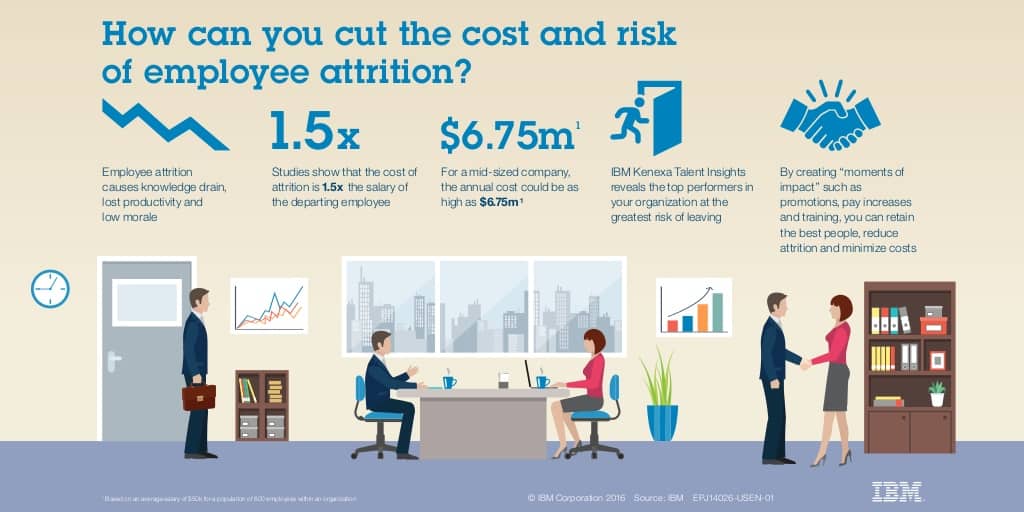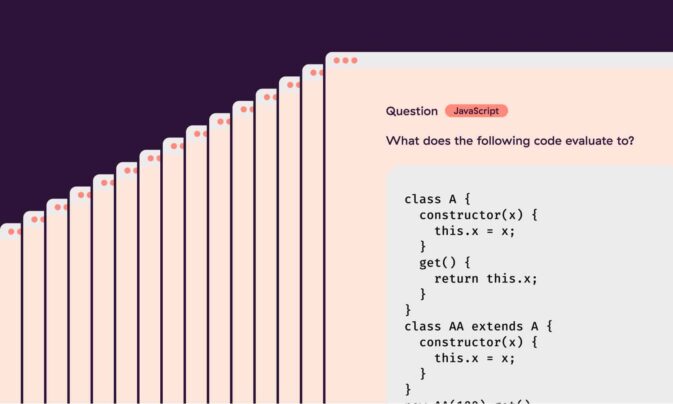The Great Resignation, or employee attrition, is here, and since 2021, over 19 million workers in the US have resigned from their positions. Organizations are hemorrhaging talent at an alarming rate, and very few managers know how to actually heal the gaping wound of employee attrition instead of just using a bandaid.
The answer is simple: companies need introspective surgery to keep workers happy. But how do you suture the wound before your business flatlines?
We’re here to help you. In the below sections, we’ll define employee attrition, discuss how to understand and measure the attrition rate and list a few ways to prevent it.
TL;DR – Key Takeaways
- Employee attrition refers to the natural reduction of the workforce due to resignations, sickness, or retirement. Natural attrition is inevitable and shouldn’t be feared.
- Monitoring employee attrition and tracking the attrition rates is crucial for organizations to understand the state of their workforce.
- Employee attrition and employee turnover are different concepts. Attrition occurs when an employee departs voluntarily or is let go, while turnover involves only voluntary resignations.
- There are two types of employee attrition: voluntary and involuntary. Voluntary attrition happens when an employee chooses to leave before the employment agreement ends, while involuntary attrition occurs when an employee is laid off or fired.
- Organizations can lower employee attrition with strategic hiring, transparent job ads, and assessing company culture fits.
What is employee attrition?
Employee attrition refers to the inevitable reduction of the workforce, typically due to resignations, sickness, or an aging workforce when employees retire – and it also includes involuntary attrition when employees are let go. If the employee attrition percentage is too high, it can quickly cripple any burgeoning business.
As such, tracking and monitoring the attrition rate is a key hiring metric for companies of all sizes. Keeping an eye on this metric will give organizations insight into the current state of their workforce and help them stay ahead of any sudden staff reductions.
Employee attrition vs. employee turnover
Employee attrition and employee turnover are often confused as they both involve employees leaving a company. However, there are some key differences between the two that are worth noting.
Employee attrition occurs when a staff member departs a company, which results in a diminishing workforce. Reasons for employee attrition can be either voluntary or involuntary, which we’ll discuss later in the article.
Turnover, on the other hand, is when employees depart on their own accord, and the company actively seeks out a replacement for the departing employee — it’s the nature of all well-organized companies.
Having an understanding of the differences between employee attrition and employee turnover can help organizations gain insights into the nature of employee departures and devise strategies to manage them effectively.
Types of employee attrition: voluntary vs involuntary attrition
Now, we’re going to look at the differences between voluntary and involuntary employee attrition.
Voluntary attrition
Voluntary attrition is when an employee chooses to leave their job before their contract or employment agreement is over. Companies often provide voluntary severance packages to those departing employees, which typically involve financial compensation based on the individual’s tenure or educational expenses.
Involuntary attrition
Involuntary employee turnover, or involuntary separation, happens when an employee is laid off or fired. Reasons for this, such as seasonal downturns or closure of a department, are typically due to budget cuts, restructuring, or other causes. It differs from a voluntary attrition turnover as it usually happens suddenly, with no warning from the employer.
Internal attrition
Additionally, there’s another type of employee attrition – internal attrition. Internal attrition is a consequence of internal mobility, when employees move between teams, departments, or divisions but stay within the company.
Typically, it isn’t a cause for concern as, technically, the employee doesn’t leave and continues to contribute to the company’s success. However, a high internal attrition rate in one team or department can signal management problems and is worth investigating further.
How to calculate employee attrition rates?
To calculate employee attrition, the process involves dividing the average number of departures within a specific period by the average number of employees during that same period. Multiplying the result by 100 yields the employee attrition rate expressed as a percentage.
This metric signifies the remaining workforce after departures, essentially measuring the extent of manpower loss.
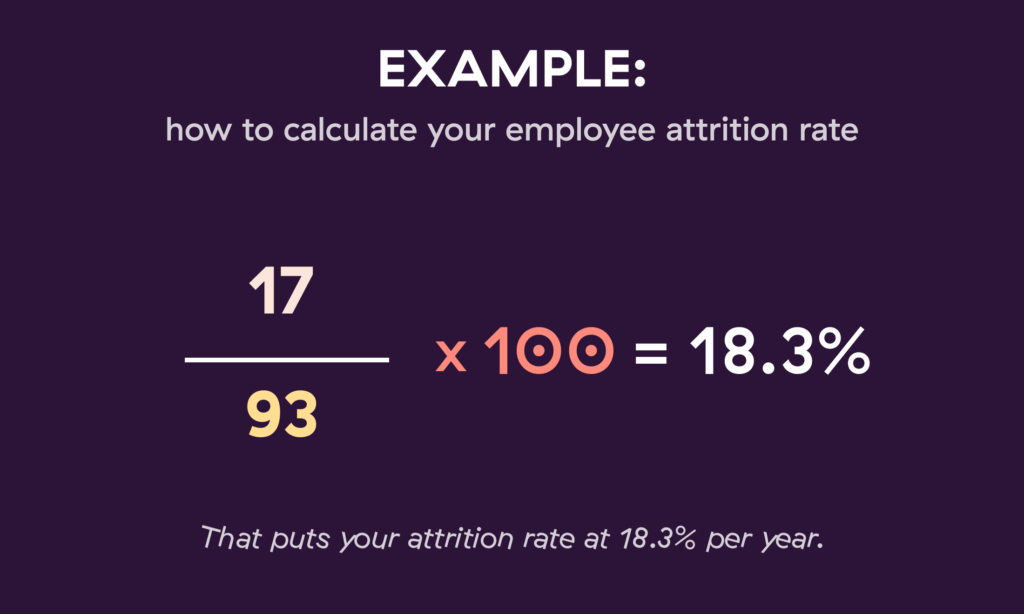
It’s important to note that the employee attrition rate calculation does not directly measure employee retention or turnover. Instead, it evaluates the organization’s ability, speed, and effectiveness to replace departed employees with new employees if it is feasible.
What’s an acceptable employee attrition rate?
You should aim for a maximum of 10% employee attrition rate. Anything higher means that your company’s employee attrition rate is above average and should immediately call for a closer evaluation of your company’s culture, operations, and overall employee experience.
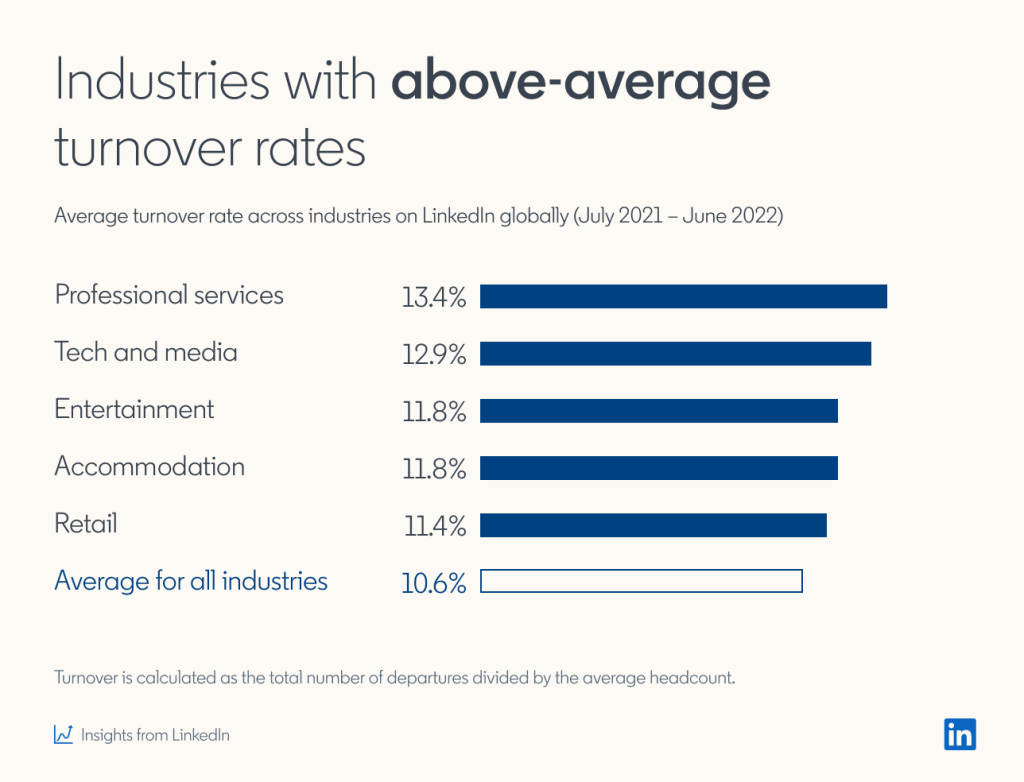
What are the common reasons for a high employee attrition rate?
Think back to personal reasons why you left a job: the salary was too low, you weren’t appreciated, or the company just wasn’t the right fit for you. Those are often the reasons why employees leave for (mostly) greener pastures.
Why your employee attrition rate is high
Here are 10 reasons why your employee attrition rate might be too high:
1. Lack of employee purpose
Many high-performing employees seek meaningful work and want to be part of a company that has a purposeful mission. Companies that connect their products or services to positively impacting and supporting charitable causes tend to have lower turnover rates. Employees who believe in the company’s mission and purpose feel motivated to stay.
2. Poor compensation
Compensation and benefits play a significant role in job changes, especially for younger workers. Competitive pay is a way for companies to show that they value their employees’ contributions and reduce the risk of competitors poaching their top talent. It’s important for companies to review an employee’s annual salary.
3. Being overworked
Burnout occurs when employees are constantly asked to do more without sufficient resources or support. It’s essential to address factors like excessive workload, lack of control, inadequate rewards, toxic work environments, fairness issues, and conflicting values. Companies can reduce burnout by actively listening to employee feedback and increasing job satisfaction.
4. Bad managers
Toxic managers who take credit for others’ work or fail to effectively manage their teams contribute to why an employee resigns. It’s crucial for HR teams to identify managers who lack the necessary skills to lead and either transition them to different roles or provide support and training to improve their management abilities.
5. Lack of feedback or recognition
Meaningful feedback and recognition from managers play a vital role in employee engagement. Employees who receive positive feedback from their managers (and other employees) are more likely to be engaged and less likely to actively search for new jobs.
6. Poor work/life balance
Achieving a healthy work/life balance is a top priority for many employees. Companies can support work/life balance by offering flexible schedules and remote work options when feasible. Utilizing technology to optimize scheduling, manage time-off requests, and improve absence management can contribute to better work/life balance for valuable employees.
7. Boredom
Experienced employees often leave organizations when they feel unchallenged and disengaged. Effective managers should assign stimulating projects, encourage a growth mindset, and foster a culture that values skills development and taking calculated risks. Creating an environment where failure is accepted as a part of growth is also crucial.
8. Limited growth and development opportunities
Employees are more likely to leave their jobs when they don’t see opportunities for career growth and advancement. Building a culture that prioritizes employee development through training, career services, mentoring, and leadership programs is key. Offering avenues for learning and aligning business goals with employee career goals can help retain valued talent.
9. Flawed hiring procedures
Low short-term retention rates and high termination rates are indicators of problems in the hiring and onboarding processes. It’s important to be transparent about the company culture during the hiring process and provide candidates with realistic expectations to improve retention.
10. Toxic or negative culture
A toxic work culture where employees feel unheard, undervalued, or unsafe leads to significant turnover. Cultivating a positive work culture requires open and frequent communication between executives and employees, fostering a respectful and empowering environment, trusting employees to do their jobs without micromanagement, and promoting a culture of inclusion. It’s essential for leaders to demonstrate their commitment to creating a healthy work culture.
A high employee attrition rate can be positive
It’s not all doom and gloom when employees leave. In fact, it might actually be to your advantage.
1. Goodbyes don’t need to be difficult
If an employee is leaving you because they have to move on with their life, goodbye will not be nearly as unpleasant as if they were leaving involuntarily. You can part on good terms and perhaps even reunite in the future.
2. Easing your financial burden
This could be a relief until you’re ready to hire someone new for the same or similar role. The average employee exit costs about 33% of their annual salary, so while you’ve still got a cost, it is 2/3rds less than it would otherwise have been.
3. They weren’t a good fit
Thirdly, the employees leaving might not have been a good fit to start with in terms of culture, poor performance, values, or something else. In this sense, employee attrition could actually be beneficial.
If a valued employee leaves you, it can be hard not to take it personally — especially if you’re a new founder or direct manager — but you can prevent it. In fact, there are quite a few ways to prevent outstanding staff members from departing your business.
How to reduce employee attrition
Although the reasons for employee attrition are often something you cannot prevent, there are a few things that you can do to positively affect and reduce employee attrition.
1. Strategic Workforce Planning and Hiring
The simplest way to reduce employee attrition is to hire the right people in the first place.
Carefully evaluate your organization’s needs and develop a hiring plan aligned with your long-term goals. Consider future growth plans and hire for roles that have a sustainable place within your company structure. Employing skills-based hiring practices can help you find the right skills match while providing candidates an accurate picture of what the day-to-day on the job will look like.
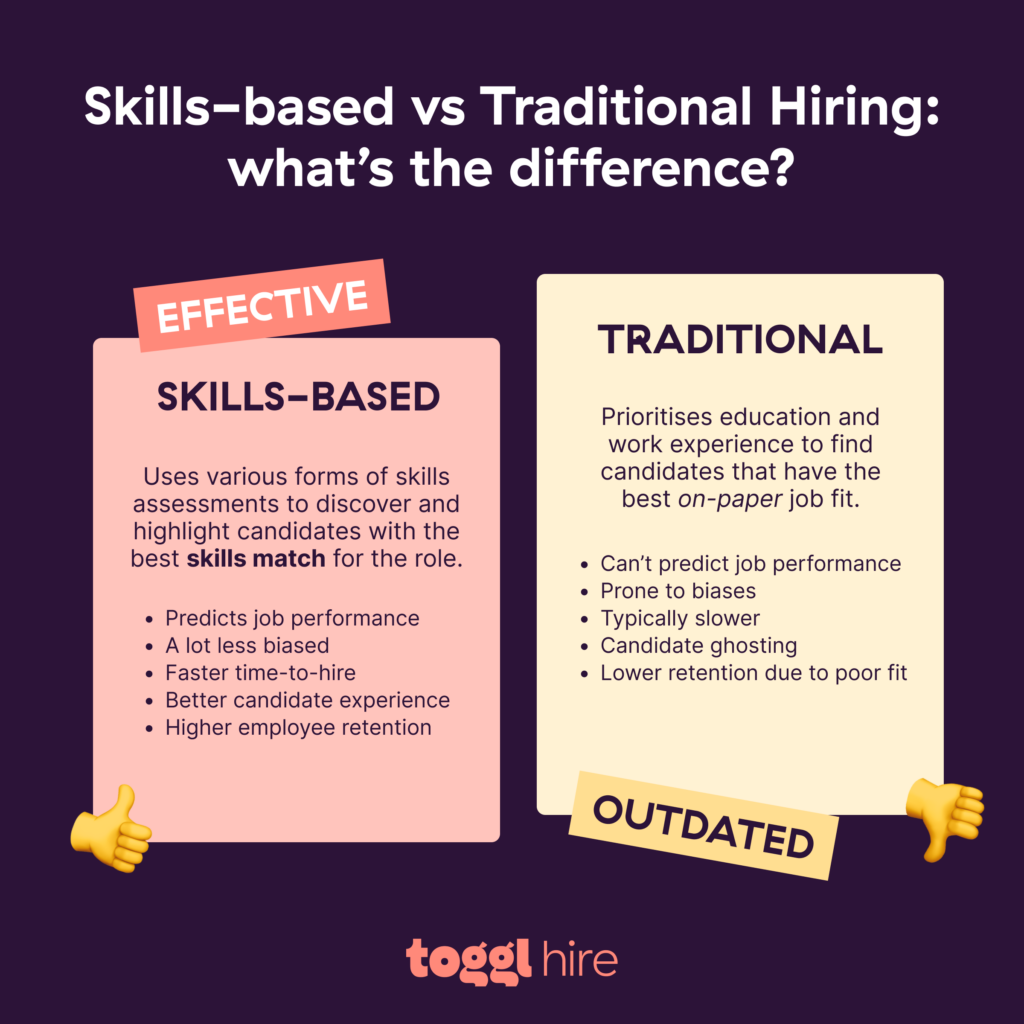
Google utilizes a data-driven approach to identify critical roles and predict future talent needs. Their strategic hiring practices ensure that they align their diverse workforce with evolving business demands.
2. Contingency Planning for Worst-Case Scenarios
Create contingency plans for unforeseen circumstances that may require significant workforce adjustments, such as industry disruptions or economic downturns.
During the COVID-19 pandemic, some companies like Airbnb implemented measures like reducing executive salaries, implementing a temporary hiring freeze, and reassigning employees to different roles to manage the impact on their workforce.
3. Transparent and Honest Job Ads
Ensure job advertisements provide accurate and honest information about the position, responsibilities, and work environment. Transparency in job ads helps set realistic expectations for candidates and reduces the likelihood of employee attrition and layoffs due to misalignment.
Buffer, a social media management company, openly shares detailed job ads that include information about their remote work culture, values, and benefits, leading to better candidate fit and reduced employee attrition.
4. Assessing Company Culture Fit
Develop effective methods to assess cultural fit during the hiring process to ensure candidates align with your organization’s values and work environment.
Zappos, known for its strong culture, conducts multiple interviews and incorporates cultural fit assessments to ensure prospective employees share their core values and can thrive within their unique work culture.
5. Respectful Employee Offboarding
When circumstances necessitate employee separations, handle the process with transparency, honesty, and empathy. Respectful offboarding experiences can help maintain positive relationships and minimize negative impacts on remaining employees.
LinkedIn has a dedicated offboarding process that includes exit interviews, providing resources for career transition, and maintaining alumni networks, fostering goodwill and potential reconnection in the future.
If you do have to let your employees go for reasons you can’t control, do it the right way. Be transparent, honest, and vulnerable – they’ll respect you more for it in the long run.
Are there signs that I can look out for?
While it’s important to understand that employee attrition isn’t always negative, keeping a close eye on your workplace dynamics is crucial to catch any red flags before they escalate.
Just like turnover, employee attrition reveals valuable insights about your employer branding, hiring practices, and overall workplace culture.
Here are some signs that may indicate a higher risk of employee attrition in the future. By staying attuned to the heartbeat of your workplace, you can pick up on these indicators:
• Frequent Absences — If an employee is frequently absent, it could signal various issues. They might be dealing with personal matters or actively exploring other job opportunities. While it’s important to respect privacy, it’s worth understanding the reasons behind their frequent absences.
• Lack of Engagement — Pay attention to employees who appear to be going through the motions despite seemingly performing well. A sense of disengagement or a lack of enthusiasm could point to underlying dissatisfaction or a desire for new challenges.
• Decreased Productivity — When employees consistently miss their performance targets or fail to meet key objectives, it could be a sign that something is amiss. They might be demotivated due to job dissatisfaction or spending their time and energy elsewhere, such as job hunting.
Remember, the key is fostering open communication channels with managers and employees.
You can cultivate an environment of trust and transparency by maintaining regular check-ins, team meetings, and feedback sessions. This allows you to spot potential employee attrition risks early on and take proactive measures to address them. By staying connected with your team, you’ll be better equipped to create a positive work environment that promotes engagement, satisfaction, and employee retention.

Juste loves investigating through writing. A copywriter by trade, she spent the last ten years in startups, telling stories and building marketing teams. She works at Toggl Hire and writes about how businesses can recruit really great people.

